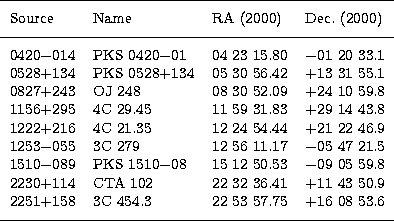

Up: BVR photometry of comparison
Subsections
Table 1 lists the 9 quasars for which photometric sequences were
obtained; coordinates at the 2000 equinox are given. BVR magnitudes of the
reference stars are reported in Table 2, together with their
uncertainties ( ) and the number of observations (N) for each band.
For 10 stars VR magnitudes only are given. The magnitude and uncertainty
evaluation has been performed as in Paper I.
) and the number of observations (N) for each band.
For 10 stars VR magnitudes only are given. The magnitude and uncertainty
evaluation has been performed as in Paper I.
Table 1:
List of the quasars for which photometric sequences are derived
|
|
Finding charts for the stars identification are shown in Figs. 1-9. They
are  wide; north is up and east is on the left.
wide; north is up and east is on the left.
The blazar PKS 0528+134 has recently been pointed for long periods
of time by the Compton Gamma Ray Observatory (CGRO); consequently,
international collaborations have been started in order to intensify the
study of this object at different wavelengths.
We are not aware of any photometric sequence in its field, so that our work
can offer a way to calibrate the large amount of optical data expected from
this huge monitoring campaign.
We have to notice that Star 2 of our photometric sequence (see Fig. 2) is not a point-like source and, in good-seeing nights, it
appears as a double object.
![\begin{figure}
\centering
\includegraphics[width=8.4cm]{ds1501f1.eps}\end{figure}](/articles/aas/full/1998/12/ds1501/Timg6.gif) |
Figure 1:
Finding chart of PKS 0420-01 |
![\begin{figure}
\centering
\includegraphics[width=8.4cm]{ds1501f2.eps}\end{figure}](/articles/aas/full/1998/12/ds1501/Timg7.gif) |
Figure 2:
Finding chart of PKS 0528+134 |
Table 2:
BVR magnitudes of the comparison stars
|
|
The magnitudes determined for Stars 2, 4, and 5 in the field of OJ
248 are in agreement, within the errors, with those published by
Villata et al. (1997) for Stars A, C, and B.
![\begin{figure}
\centering
\includegraphics[width=8.4cm]{ds1501f3.eps}\end{figure}](/articles/aas/full/1998/12/ds1501/Timg12.gif) |
Figure 3:
Finding chart of OJ 248 |
A photometric sequence was published by Smith et al. (1985); BVR standard magnitudes of the same stars were also
measured by Villata et al. (1997), substantially confirming the previous results. Stars
13, 14, and 15 in the above works correspond to Stars 2, 3, and 4 in the
present paper and the calibrations agree within the errors. We add one star
(Star 1), brighter and closer to the quasar.
A comparison among the different calibrations is performed in Table
3.
![\begin{figure}
\centering
\includegraphics[width=8.4cm]{ds1501f4.eps}\end{figure}](/articles/aas/full/1998/12/ds1501/Timg13.gif) |
Figure 4:
Finding chart of 4C 29.45 |
Table 3:
Comparison among different calibrations in the field of 4C
29.45
|
|
![\begin{figure}
\centering
\includegraphics[width=8.4cm]{ds1501f5.eps}\end{figure}](/articles/aas/full/1998/12/ds1501/Timg15.gif) |
Figure 5:
Finding chart of 4C 21.35 |
BVR magnitudes of Stars 1 and 5 are published in Villata et al. (1997; their Stars D and A); they are in agreement with the
present values with the only exception of the V magnitude of Star 5.
The object "S" in Fig. 6 is characterized by large-amplitude
and rapid variability. Its coordinates are  ,
,  . It has been named
"Simona" in Villata et al. (1998b).
. It has been named
"Simona" in Villata et al. (1998b).
![\begin{figure}
\centering
\includegraphics[width=8.4cm]{ds1501f6.eps}\end{figure}](/articles/aas/full/1998/12/ds1501/Timg16.gif) |
Figure 6:
Finding chart of 3C 279 |
BVR magnitudes of two among the six comparison stars calibrated in the
present work are reported in Villata et al. (1997):
Stars A and B in that paper are our Stars 4 and 6. The respective magnitudes
are in accordance within the errors, apart from the B magnitude of Star 6.
![\begin{figure}
\centering
\includegraphics[width=8.4cm]{ds1501f7.eps}\end{figure}](/articles/aas/full/1998/12/ds1501/Timg17.gif) |
Figure 7:
Finding chart of PKS 1510-08 |
A UBV photometric sequence for 3C 454.3 was determined by Angione
(1971); four stars of that sequence (plus another star) were
recently calibrated in VRI by Fiorucci et al. (1998).
A comparison among calibrations is performed in Table 4: a
general agreement is found, when considering the large estimated
uncertainties affecting some data. We notice that the magnitudes of Star 1
published by the quoted authors are lower than ours; we suspect that this
could be due to a contribution to its flux by the fainter star close to it
(see Fig. 9), when the photometry is performed with large aperture.
Table 4:
Comparison among different calibrations in the field of 3C
454.3
|
|
![\begin{figure}
\centering
\includegraphics[width=8.4cm]{ds1501f8.eps}\end{figure}](/articles/aas/full/1998/12/ds1501/Timg18.gif) |
Figure 8:
Finding chart of CTA 102 |
![\begin{figure}
\centering
\includegraphics[width=8.4cm]{ds1501f9.eps}\end{figure}](/articles/aas/full/1998/12/ds1501/Timg19.gif) |
Figure 9:
Finding chart of 3C 454.3 |


Up: BVR photometry of comparison
Copyright The European Southern Observatory (ESO)

![]() wide; north is up and east is on the left.
wide; north is up and east is on the left.
![]() ,
, ![]() . It has been named
"Simona" in Villata et al. (1998b).
. It has been named
"Simona" in Villata et al. (1998b).